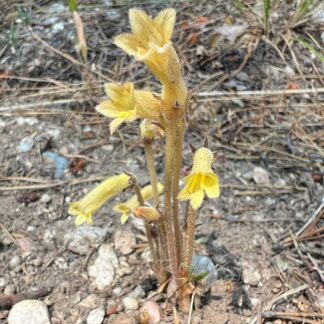interesting bits
Showing 1–12 of 109 results
-

Allium schoenoprasum / chives
- globe-shaped umbels of pink flowers with darker midveins (stripes)
- hollow, tubular leaves and flower stalks
- smells like onions
- grows from bulbs in clumps or sometimes individually
- wild in wetlands, fens, meadows; cultivated in gardens
-

Anemone multifida / cutleaf windflower
- usually 5 bi-colored "petals" - esp. pink or white; many stamens
- leaves deeply cut and re-cut in 3s with rounded or pointed tips
- stems and lower leaf surfaces usually hairy
- gone to seed, fruits have a troll-doll look
- on calcareous ledges, in shallow crevices or rocky outcrops; dry mountain tops or near water
-

Aphyllon franciscanum / yellow-clustered broomrape
- tubular yellow, 5 petalled flowers
- short (6")
- no leaves at all, ever
- very hairy stems and flowers
- parasitic, especially on buckwheats
-

Apocynum androsaemifolium / spreading dogbane
-
short and spreading perennial
-
oval leaves with pointed tips, prominent veins
-
clusters of teeny, pink, bell-shaped flowers with recurved petals
-
conspicuous darker pink stripes on inner surface of corolla
- exudes milky sap when stems or leaves are broken
-
-

Apocynum cannabinum / common dogbane
- herbaceous perennial with red stems and long/narrow leaves
- leaves have prominent veins
- leaves and stems exude white latex if broken
- white, bell-shaped flowers held erect in stalked clusters
- seedpods long, thin and brownish; in pairs
- often near streams or in moist places
-

Argentina anserina / silverweed
- silvery, compound leaves on low, creeping stems
- yellow, 5+ petaled flowers; lots of stamens
- fens, other wetlands, but also roadsides
-

Artemisia ludoviciana / white sage
- low, spreading perennial - up to 3 feet tall
- silvery leaves and stems (hairy)
- leaves lance shaped, but sometimes lobed
- shoots die back in winter
- aromatic
-

Artemisia tridentata / mountain big sagebrush
- medium-sized grey-green shrub
- highly aromatic
- tall, spikey inflorescences with many clusters of invisible flowers
- limited to drier habitats (not the Valley basin)
-

Astragalus miser / timber milkvetch
- compound leaves with small, egg-shaped leaflets
- teeny, pea-like flowers - bicolored but overall blue/purple
- keel tip is purple and pointed
- small, hairy seed pods
- grassland, meadows, and other open communities
-

Astragalus purshii / woollypod milkvetch
- low growing, silvery, compound leaves; no tendrils
- magenta (or white) "pea-like" flowers with darker keel petal
- "congested" inflorescence
- found in very dry areas, not in shade
-

Balsamorhiza macrophylla / cutleaf balsamroot
- large, yellow, sunflower-like blossom
- large, dissected/lobed/compound-looking leaves
- up to 40" tall
- roadsides or hillsides with arrowleaf balsamroot and Wyethia
-

Bassia scoparia / burningbush
- large, annual herb (forb)
- leaves long-ish and narrow
- inflorescence a highly branched spike with teeny green/yellow flowers
- may form huge, invasive colonies
- whole plant turns red in fall
- a tumbleweed
- especially in disturbed areas and wastelands in the Valley
Showing 1–12 of 109 results